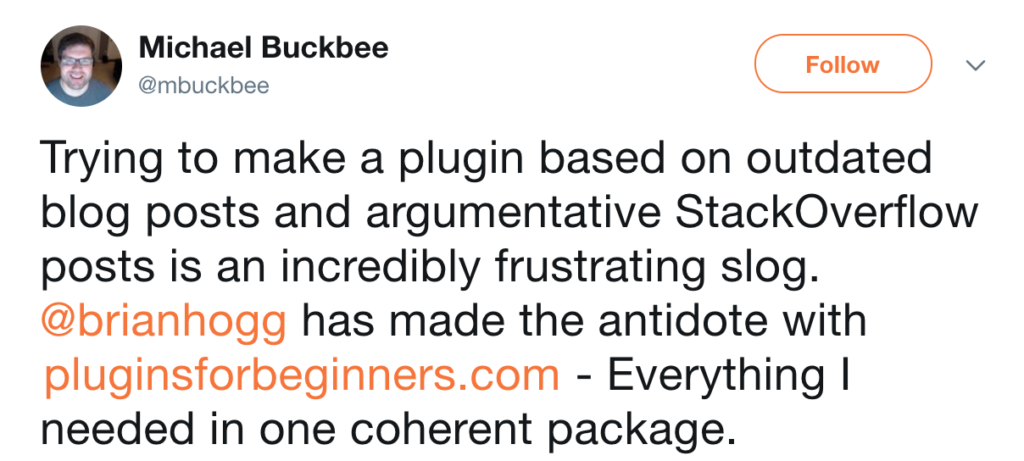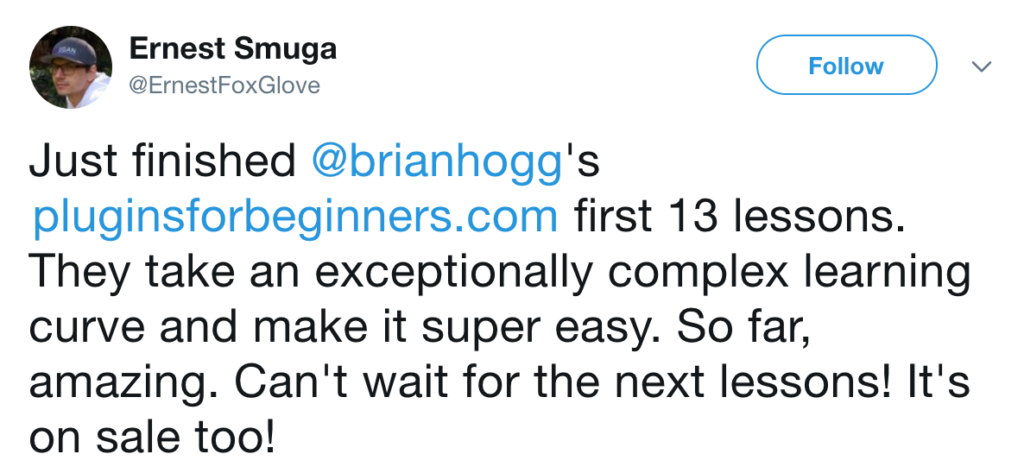Already purchased? Login here
Learn WordPress Plugin Development
Are you looking to level up your skills and learn to create WordPress plugins instead of just installing them? You've come to the right place. You'll learn how to install the tools you need, all the way up to learning the essential WordPress plugin development tasks.
Learn to build your own custom WordPress plugins
There's a lot of WordPress plugins out there you can use, but what if you (or your paying client or employer) wants something that doesn't exist, or maybe works a bit differently? Where do you start?
This course will teach you the fundamentals of building WordPress plugins. I'll save you hours of googling around the internet trying to find what you need, and hopefully stop you from hacking things together 🙂
What Will I Learn?
We'll cover the essential topics like:
- Installing a development environment on your own machine to work on your plugin
- What makes a plugin
- The basics of PHP (the language WordPress is built with)
- The building blocks of WordPress functionality (actions and filters)
- How to build a settings page for your plugin
- How to work with posts, pages and The Loop
- Fetching and saving data
- Adding and working with shortcodes
...and some more advanced topics like:
- Ways to protect your code from security threats
- Using your plugin to customize other plugins (so meta...)
- Tracking changes to your plugin code using Git version control
- Getting your plugin ready for translation into other languages
- How to save your data to a custom table (and why you'd want to)
All in short, easy to digest videos you can refer back to later!
Who Is This For?
Almost anyone who's looking to create WordPress plugins for clients, your employer, or to release to the public.
Those with a lot of programming experience will be able to go through this course quickly, but I've tried to structure the course to walk you through every step of the way.
That said this isn't programming 101. If you have no concept of things like variables, loops, functions, if statements and the like, you might want to go through something else first. I will go through the syntax in PHP (the language you'll be coding your plugins with).
Likewise, if you have no understanding of basic HTML and CSS, this might not be the course for you.
- Those coming from another language like JavaScript, Python or Ruby, but looking to quickly grasp WordPress development
- Existing developers who want to create a plugin for release (for free and/or as a premium paid plugin)
- WordPress site creators and maintainers wanting to provide additional services to their clients or employer
- Anyone with an understanding of basic programming concepts who wants to apply those skills to customizing WordPress sites
Not sure if it's for you?
100% money back guarantee
"Great course! It really answered every single question I had regarding preparing a plugin the correct way. I really enjoyed it, and I am applying that knowledge to a plugin I'm building."

Colby Albarado
Owner, Eyebox Media LLC
Course Outline
Each video breaks down a concept of WordPress plugin development and allows you to refer back to it easily in the future.
All videos are professionally recorded in HD.
...and any other additions to the course in the future!
"Brian is one of our most dedicated and inspiring teachers/mentors and has been with our chapter since we launched in 2013. Our learners thrive under his instruction and the projects we see by the end of the class reflect the confidence and newfound excitement for technical skills he fosters in our classroom. We’re delighted to have him involved with Ladies Learning Code and would encourage anyone to learn from him."

Meg Smith
Hamilton Co-Lead, Ladies Learning Code
What You'll Get
The course is still being completed, but Plugins for Beginners is available now in early access for anyone who wants to get started right away.
You'll get:
- Instant access to the private course area
- Watch the 23 lessons right away
- Lifetime updates and access to all new content created for the course

Still not sure about Plugins for Beginners?
With my guarantee, you have zero risk in registering for the course.
If within 30 days of registering for the course you feel you haven't learned how to start creating your own WordPress plugins, let me know and I'll refund your money.
I'm confident however that you'll have all the tools you need to start quickly creating your own plugins, and be able to refer to the videos in the course as you continue to develop your plugins for clients or public release.
Frequently Asked Questions
Can I get a full invoice?
You can! Just login to your account and click 'Generate Invoice' to get a full invoice for accounting purposes.
How do I watch the videos?
Once you buy the course, you'll get access to the private course area where you can watch all the videos. All videos were professionally recorded in HD with high quality audio, so they'll be easy to listen to!
Do I get lifetime access with no monthly/yearly fees?
Yes!
What if I'm not happy with the course?
I really want you to get value out of the course, and only want your money if you're happy with it! If you aren't, please send an email by replying to the welcome email you receive within the first 30 days and I'll refund you.
Can I purchase multiple copies of the course for my team at a reduced price?
Yes! Email me and we can work something out for your team.
I have another question!
No worries! Send me an email 🙂

Meet Brian Hogg
Hello! I'm @brianhogg, creator of three premium plugins, author of Working with WordPress and JavaScript, former lead organizer of WordPress Hamilton, and co-host of the Selling Plugins series.
I also teach on my blog, through screencasts, and speaking at conferences.
Here's some nice things people have said about my courses:
This is really excellent for those looking to get into commercial #WordPress plugins https://t.co/VuJOwW1g6s
— Pippin Williamson (@pippinsplugins) February 12, 2017
I've done the first couple of modules and loving it so far. https://t.co/ohNnOSmCcU
— Christine (@SmoothSailingHI) November 20, 2017
had a great time with @brianhogg on his ProPlugins Course. I learned a lot from his course. wish if he had done this couple of years ago 🙂 pic.twitter.com/yk7yb4aQGe
— Muhammad Adnan (@hiddenpearls) February 22, 2017
@brianhogg, thank you for the AMAZING "Working with JavaScript and WordPress" course on @pluralsight! Highly recommended! #WordPress
— Yuriy Vasilyev (@yuriivasyliev) April 28, 2016
Just finished this @pluralsight course about #WordPress and #Javascript by @brianhogg it was amazing! pic.twitter.com/gyOrAAcqUN
— Juan De la torre (@JuanDevWP) March 16, 2016
So thanks to @brianhogg I've now launched https://t.co/7SgjKNVpO0. Use code TLAUNCH for 20% off until next Sunday #WordPress #SVG #Security
— Daryll Doyle (@enshrined) March 3, 2017
Still not ready? Sign up for sample lessons to help you get started.

